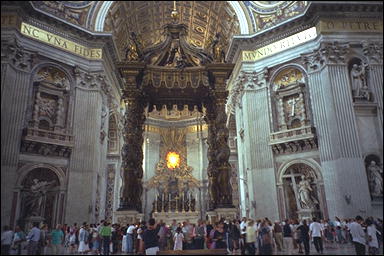Wednesday, September 17

Great Churches of the World:
Second Thoughts on St. Peter's and the Baroque
I began my architectural meditations this morning on the Tempietto, the symbol of the cool, intellectual perfection of the Renaissance; and I end it at St. Peter's Basilica, another martyrium to the same martyr, the exempluum of the Baroque epoch. I've avoided discussing the great basilica thus far, not in detail, and perhaps it's because I've only been beyond the portals of the church only once this trip for one reason or another. I am afraid not to do it justice; but doing justice to the most famous church in Christendom is something that is very difficult.
St. Peter's is a difficult church, a problematic shrine. Some pilgrims, accustomed to the gloomy (and splendid) solitude of Gothic cathedrals or the antique coziness of the churches of the American heartland (or even, perhaps, the chill airplane-hanger church down the street), find it leaves them cold. And as I said before, emotionally, it is a monstrous, cavernous building at first glance.
However, such thoughts fail to understand the essence of this glorious church. Nobody has ever truly seen St. Peter's; it's too familiar to be seen. Our notions of it are already present by pictures in art books, our love or our contempt for the Office which it represents, by crude elevations on dog-eared holy cards that show Maderno's "incorrect" facade overshadowed by St. Joseph as patron of the Universal Church.
The problem of coldness is a difficult one, but at the same time is something of a straw man. St. Peter's is not a building for the faint of heart precisely because it courses with emotion, whatever the size or scale. It is baroque, and the baroque is the marriage of feeling with intellect. Every detail of the structure, from gargantuan Solomonic column to the tiniest gilt-headed cherub, is meant to engage us subjectively and pull us finally towards an intellectual, objective truth, the glory of God, the subursted dove of the Holy Ghost we saw so palely before in the dome of the Tempietto. The baroque is a prophesy of John Paul II's phenomenology, where the objective truths resonate in our subjective souls.
We don't understand the baroque today because we don't understand emotion. I even made the mistake myself, somewhat in reverse. I neglected the Roman architecture of the era as too classical and conventional. It isn't, trust me: you can't call anything that produced the sacred mystical-marital bliss of the Ecstasy of St. Teresa staid. Instead I looked towards the whimsical pastels and stucco filigree of the stage-set churches of Bavaria and Latin America as the real essence of the movement. While splendid, these more eccentric outliers miss the point as well.
The baroque is derided as sham architecture, plaster and chickenwire patched up with gilt. But just as often, it is an architecture of polychrome marble and pockmarked travertine. Baroque is solid. Baroque is marble. At her heart, she is stone, not plaster. She is not caprice and whimsy (and thus a sham), and since we have elevated fickleness and crowned her as the queen of our false emotions, we can only assume an art based on an appeal to hearts and minds must be mindless, that an art based on leading us to truth must be necessarily untrue.
Nothing about the interior, the gesticulating bronze bishops and innumerable marbles is fickle or cold, two extremes of the same lie about the baroque. We're afraid to respond to the baroque: it seems cheap, theatrical, undecorously happy, and thus false, immoral. But we forget that even if the happy angels were perhaps feigned, the smiles on men like the laughing St. Philip Neri were not.












